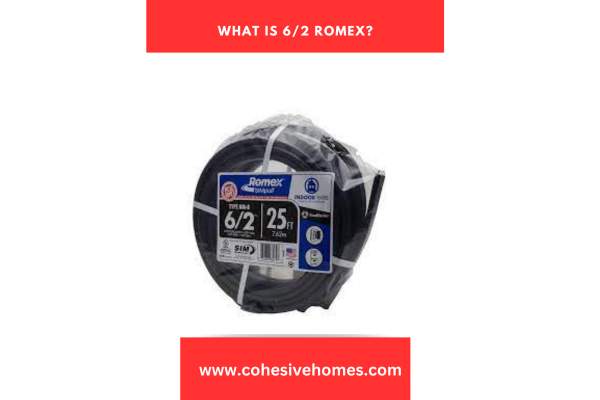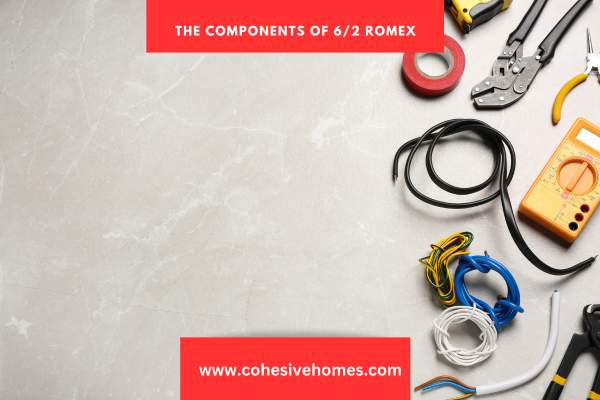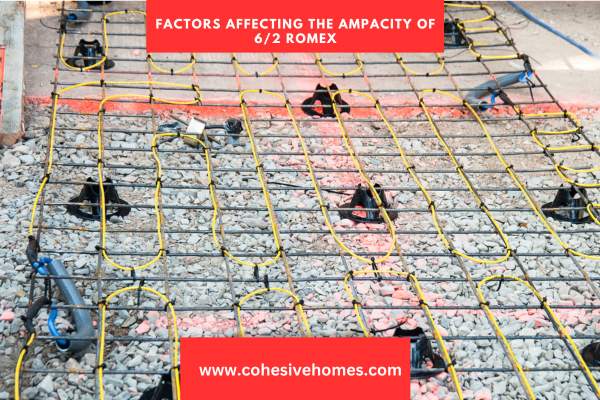Welcome to our blog post, where we dive into the fascinating world of electrical wiring and shed light on the capabilities of 6/2 Romex. If you’re a DIY enthusiast or simply curious about electrical installations, you’ve likely encountered Romex before. Romex, a brand of non-metallic sheathed cable (NM), has become a popular choice for residential wiring due to its versatility and ease of installation. One common question that arises is, “How many amps is 6/2 Romex good for?
In this article, we focus specifically on 6/2 Romex and unravel the mysteries surrounding its ampacity.
Ampacity, the maximum current that a wire can safely carry, is a crucial factor to consider when selecting the appropriate wiring for a specific electrical load.
Understanding the ampacity of 6/2 Romex is essential to ensure the safety and efficiency of your electrical system.
What is 6/2 Romex?

6/2 Romex is a type of non-metallic sheathed cable that consists of three conductors: two insulated hot wires, and a bare copper grounding wire.
The “6/2” designation signifies that the cable contains six-gauge conductors, with two hot wires and one grounding wire.
The conductors are typically color-coded, with the hot wires being black and red, while the grounding wire is bare copper.
6/2 Romex is commonly used for applications requiring a higher ampacity, such as heavy-duty appliances or electric vehicle charging stations.
It is important to note that 6/2 Romex is designed for use in dry locations and should not be exposed to moisture or damp environments.
The Components of 6/2 Romex

To understand the ampacity of 6/2 Romex, it is essential to be familiar with its components. The cable consists of three main elements:
- a) Conductors: 6/2 Romex contains two hot conductors and one grounding conductor. The hot conductors are responsible for carrying the electrical current, while the grounding conductor provides a path for electrical faults to safely discharge.
- b) Insulation: The conductors in 6/2 Romex are insulated with a thermoplastic material, typically PVC (Polyvinyl Chloride), which provides protection and electrical insulation. The insulation helps prevent accidental contact with live wires and reduces the risk of electrical shocks or short circuits.
- c) Sheath: Surrounding the conductors and insulation is a protective outer sheath, which is typically made of PVC or a similar material. The sheath provides mechanical protection to the internal components and ensures the overall durability and safety of the cable.
Understanding these components is crucial for comprehending the ampacity of 6/2 Romex and its suitability for specific electrical applications.
Understanding Ampacity: A Key Consideration

Ampacity is a fundamental concept when it comes to electrical wiring. It refers to the maximum amount of electrical current that a wire or cable can safely carry without exceeding its temperature rating.
Ampacity is determined by several factors, including the wire gauge, insulation material, ambient temperature, and installation methods.
In the case of 6/2 Romex, the ampacity is primarily determined by the wire gauge, which in this case is six gauge.
The larger the gauge number, the smaller the wire diameter, and subsequently, the lower the ampacity.
However, it’s important to note that the ampacity of 6/2 Romex is also influenced by the insulation material and other factors.
Understanding the ampacity of 6/2 Romex is crucial for ensuring that it is appropriately matched to the electrical load it will be carrying.
Overloading the cable by exceeding its ampacity can lead to overheating, which may result in damage to the cable or, worse, a fire hazard.
Adhere to NEC guidelines for safe and reliable electrical installations with 6/2 Romex.
Next, we’ll delve into factors impacting 6/2 Romex ampacity, empowering informed decisions for electrical projects.
By understanding these factors, you can ensure the proper sizing and utilization of 6/2 Romex to meet your specific electrical needs.
Factors Affecting the Ampacity of 6/2 Romex

The ampacity of 6/2 Romex can be influenced by various factors, including the insulation material, ambient temperature, and installation methods.
Let’s explore each of these factors in more detail:
a) Insulation Material: The type of insulation used in 6/2 Romex plays a significant role in determining its ampacity.
Different insulation materials have different temperature ratings, which directly affect the maximum current-carrying capacity of the cable.
For example, cables with higher temperature-rated insulation can handle more current without exceeding safety limits. Check specifications and consult the manufacturer’s guidelines for suitable 6/2 Romex with specific insulation material for your application.
b) Ambient Temperature: The surrounding temperature in the installation environment can impact the ampacity of 6/2 Romex.
As the temperature rises, the ability of the cable to dissipate heat decreases, leading to a reduction in its ampacity. On the other hand, lower temperatures can improve the cable’s ampacity.
The National Electrical Code (NEC) provides guidelines and derating factors to account for temperature variations, enabling proper ampacity calculations for different environments.
c) Installation Methods: The way 6/2 Romex is installed can also affect its ampacity. Factors such as bundling, spacing, and the presence of insulation materials in close proximity can impact the cable’s ability to dissipate heat.
Improper installation practices that restrict airflow around the cable or cause excessive heat buildup can reduce its ampacity.
Following NEC guidelines and using appropriate installation techniques are crucial to maintain the desired ampacity and ensure safe electrical installations.
Understanding these factors is crucial for informed decisions when installing 6/2 Romex and considering its ampacity.
Consider insulation, temperature, and proper installation to use 6/2 Romex safely, avoiding hazards and ensuring system longevity.
Determining the Ampacity of 6/2 Romex

Determining the ampacity of 6/2 Romex involves considering various factors and following industry guidelines.
Let’s explore the key aspects of determining the ampacity of this cable:
a) National Electrical Code (NEC) Guidelines: The NEC provides comprehensive guidelines for electrical installations, including ampacity calculations. It specifies the ampacity ratings based on wire gauge, insulation type, and the application’s specific conditions.
These guidelines help ensure safe and reliable electrical systems. It is crucial to consult the NEC and adhere to its guidelines when determining the ampacity of 6/2 Romex.
b) Conductors in Cable vs. Individual Conductors: Ampacity ratings can differ depending on whether the conductors are in a cable assembly (like Romex) or individual conductors.
Conductors bundled together in a cable have less ability to dissipate heat compared to individual conductors.
This bundling effect affects the ampacity, requiring derating factors to be considered for bundled cables. Understanding the distinction between cable conductors and individual conductors is important when determining the ampacity of 6/2 Romex.
c) Ampacity Tables and Derating Factors: The NEC provides ampacity tables that outline the maximum allowable current for different wire sizes, insulation types, and installation conditions.
These tables account for factors like ambient temperature, bundling, and spacing. Derating factors may need to be applied in situations where specific conditions deviate from the standard assumptions in the ampacity tables.
Factors such as the number of current-carrying conductors in a conduit or cable, proximity to heat sources, or special installations may require adjusting the ampacity based on the derating factors specified in the NEC.
By referring to the NEC guidelines, understanding the differences between conductors in cable and individual conductors, and applying the appropriate ampacity tables and derating factors, you can accurately determine the ampacity of 6/2 Romex for your specific electrical installation.
Applications of 6/2 Romex

6/2 Romex is a versatile wiring option that can be used in a wide range of applications.
Its higher ampacity makes it suitable for carrying heavier electrical loads. Here are a few examples of where 6/2 Romex is commonly employed:
Residential Wiring
6/2 Romex is often utilized in residential electrical installations, especially for circuits that require a higher current capacity.
It can be used for powering appliances such as electric ranges, ovens, dryers, and air conditioning units.
It is commonly used to power subpanels and high-demand branch circuits requiring significant electricity.
Electric Vehicle Charging Stations
As electric vehicles gain popularity, the demand for dedicated charging stations is increasing. 6/2 Romex is commonly employed in these installations to handle the higher current required for fast charging.
It provides a safe and efficient solution for powering electric vehicle charging stations in residential or commercial settings.
Outdoor Installations:
6/2 Romex with appropriate insulation can also be suitable for outdoor applications where it may be exposed to weather conditions.
It can be used for outdoor lighting, powering sheds or workshops, or running electrical circuits for outdoor entertainment areas.
However, it is crucial to ensure that the specific type of 6/2 Romex being used is rated for outdoor use and protected against moisture.
These are just a few examples of the broad range of applications where 6/2 Romex can be effectively utilized. It offers flexibility and reliability, making it a popular choice for various electrical projects that require a higher ampacity.
Conclusion

In conclusion, understanding the ampacity of 6/2 Romex is essential for safe and efficient electrical installations.
Versatile 6/2 Romex offers higher capacity, ideal for residential wiring, EV charging stations, and outdoor installations.
Determining the ampacity of 6/2 Romex involves considering factors like the insulation material, ambient temperature, and proper installation methods. Adhering to the guidelines provided by the National Electrical Code (NEC) ensures that the cable is utilized within its safe operating limits.
By following industry standards, consulting ampacity tables, and applying derating factors when necessary, you can confidently select and install 6/2 Romex for your specific electrical needs.
Proper installation techniques, such as ensuring proper spacing and avoiding excessive bundling, contribute to maintaining the desired ampacity and overall electrical system safety.
Remember, safety should always be a top priority when working with electrical systems.
Consult a qualified electrician for complex installations or if you have any uncertainties about working with 6/2 Romex.
FAQS
What is the maximum ampacity of 6/2 Romex?
The maximum ampacity of 6/2 Romex depends on factors such as wire gauge, insulation material, temperature, and installation methods. Consult the National Electrical Code (NEC) guidelines and ampacity tables for specific ratings.
Can I use 6/2 Romex for outdoor installations?
Yes, but ensure you use outdoor-rated 6/2 Romex that is protected against moisture and suitable for outdoor use.
Is it safe to exceed the ampacity of 6/2 Romex?
No, exceeding the ampacity of 6/2 Romex or any cable is unsafe and can cause overheating and fire hazards. Always adhere to ampacity guidelines and consult a professional if needed.
